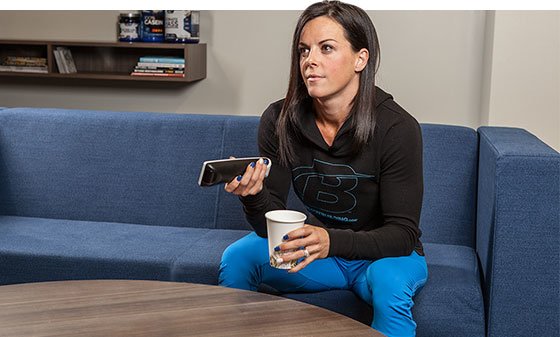Q
"How Can I Motivate My Significant Other To Work Out?"
Just like bills and household chores, fitness can mark a tipping point for relationships. It’s a challenge that might be more common than you think: one person wants to get in shape, and the other isn’t as motivated. It’s a two-fold problem and a recipe for insecurity and jealousy.
Your partner might be threatened by your newfound passion and wonder why you’re doing it or who you’re doing it for. You might feel like he or she is unintentionally sabotaging your fitness goals. If you’re steadfast with your goals and start to achieve some success, it can become frustrating when you don’t see your partner making the same effort. You feel like you are trying to improve yourself, look better, and live healthier, and your partner’s lack of passion might upset you.
So what do you do if you can’t get your spouse onboard with your new fitness goals and lifestyle? Try some of these tactics to help motivate your partner to make healthier decisions so you can live your lives together as one happy, fit family.
1
DON’T PUT YOUR PARTNER ON THE DEFENSIVE
If you want your significant other to be receptive to what you’re sharing, don’t make him or her feel ashamed about current lifestyle choices. That’s only going to spark resentment. You don’t want to bully your loved one into making a change, which often results in a negative outcome down the road. Always keep your eye on the prize, which is having a healthy and happy relationship.

2
EXPLAIN WHY YOU’RE MAKING A CHANGE
If your spouse is reacting negatively to your new fit lifestyle, it might be because your loved one simply doesn’t understand why you’re doing it. The solution? Communicate. Have a caring, understanding conversation where you explain the importance of your goals. Explain that you’re doing it both for physical health and for a healthier self image. Let your significant other know that you want to be the best person you can be, and that you want to train often and eat smart so that you can be around longer. Your relationship deserves that.
Get your partner involved by asking for help. Some people are more motivated by doing things for others than they are for themselves. In some cases, the desire to help you will be a strong enough motivator for your partner to get active, as well.
3
HELP FIND A MEANINGFUL GOAL

Just because you’re focused on achieving your goals doesn’t mean your significant other is equally as amped. Don’t assume your partner is working from your timeline. Instead of expecting him or her to feed off your energy, help your partner create inner motivation by pinning down a goal that has personal meaning. This meaning is going to propel your loved one forward and stay on-track during hard times. It has to create that spark. If your loved one is still having trouble finding a sense of purpose, help him or her set a time-sensitive goal—whether that be looking great in a bikini for an upcoming trip or shaving 20 seconds off a mile time for an upcoming race. This creates a sense of urgency, which might just be the push that’s needed.
4
CREATE A FRAME OF REFERENCE
Sometimes we don’t realize how much we’ve slid off course until someone mentions it. One of the most valuable things about a relationship is having someone who cares enough to be your mirror and be honest with you. The important thing is being honest in a non-judgmental and loving way. If your spouse knows you’re doing it out of love, and not just being hurtful, it’ll be easier for him or her to hear the truth.
Find a subtle way to bring your partner’s current health issues to light. An old photo or video is a great way for your better half to see how far his or her fitness has fallen. Another helpful reference point is getting your bodyweight and body fat tested together. While it’s a great way to see where you are for your age, it’s also a great tool for setting goals and measuring progress.
5
MAKE IT FUN
Remember that not everyone shares the same interests. Explore different exercise-related activities until your spouse finds one that he or she enjoys. Cater to your partner’s personality type. Someone who’s self-conscious might shy away from group classes, while someone who loves heights might take well to bouldering. Remember that you can’t transform fitness habits overnight. First, you have to build a foundation.

6
MAKE IT A “TOGETHER THING”
It’s easy for your partner to feel like he or she has taken a backseat to your new fitness goals. That can lead to resentment. Instead of letting fitness tear you apart, allow it to bring you together. While you don’t have to spend every moment lifting together, take the opportunity to spend some time training side-by-side. Try hitting the stepmill at the same time, or joining each other on a nightly walk or post-dinner run. Having a common interest and common goal can bring a relationship even closer together.
7
HELP CREATE MOMENTUM
Getting started is always the hardest part. Find a way to give your partner a supportive initial push without being too forceful. Help your loved one test out fun things while encouraging him or her to dismantle the excuse word “can’t.” If your partner used to like to ride mountain bikes, drop into a bike shop on a Saturday. If you’re with a guy or gal who likes MMA, get a punching bag or sign up for classes at a martial arts studio. If your partner is brand new to fitness, take him or her to the gym for the first time. All of these things are easy to do, but they’re also easily left on the backburner. Help make sure they become action, not inaction.
8
SET THE RIGHT REWARDS
Remember to reward yourself when reaching milestones. The act of treating yourself is bigger than a new pair of jeans or concert tickets. Treating yourself creates a positive association with your goals, recharges your batteries, and makes you eager to achieve your next major triumph. Help your significant other create small “stepping stone” goals and a complementary reward system that reflects something your partner really wants to do.

9
LEAD BY EXAMPLE
Sometimes the smallest things make the biggest difference. Just like having your spouse’s support makes it easier for you to stay on track, the same is true the other way around. Stay strong for both of you. If your partner sees you get lax with your training or cheat on your meals, it just makes it easier for him or her to fall off the wagon. In the beginning, you’re going to have to be strong enough for the both of you.
10
ALIGN VALUES
If all other efforts fail, take the direct approach and have a serious conversation with your partner about health. Remember that, even though this is a more direct tactic, you want to approach it with love and understanding. If you go in guns blazing, it simply won’t work. You’re just going to make your partner put up defenses. Make the conversation about values, principles, and beliefs. If you’re working hard at getting in shape and being healthy, then chances are you value your health, respect your body, and believe it’s a reflection of who you are as a person. When the personal values in a relationship aren’t in alignment, it’s bound to cause conflict. Take the time to talk things out and come to a mutual understanding. Who knows, maybe next time you’ll be headed to the gym together, hand in hand.


